Table of Contents
Update: April 23 2023
The Grand Loop Road in Yellowstone National Park takes visitors through some of the park’s most beautiful and unique natural features. If you’re considering traveling North Grand Loop Road, you’ll explore Yellowstone’s Grand Circle, which constitutes the interior roads within the park and is roughly shaped like an angled figure-eight. Most people explore making a figure 8 with an upper loop and a lower loop. The northern upper Grand Road loop figure “8” circles Mammoth Hot Springs, Tower-Roosevelt, Canyon Junction and Norris Junction, before returning to Mammoth.
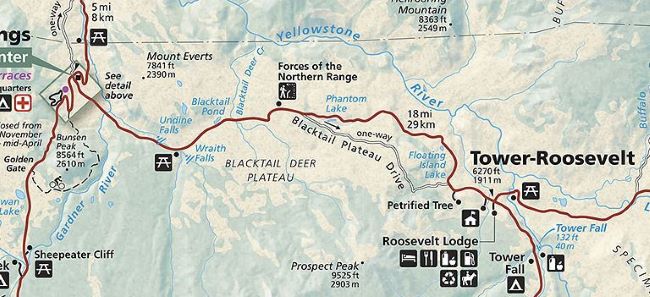
This post may contain affiliate links, meaning if you purchase something through one of these links, we may earn a small commission at no extra cost to you! Read the full disclosure policy here.
Mammoth Hot Springs to Tower Junction
Our favorite section is traveling the North Grand Loop Road between Mammoth Hot Springs and Tower Junction. The northern section of Yellowstone differs vastly from the western section and its geothermal features. The section between Mammoth and Tower features scenic mountain vistas, wildflower meadows, and peaceful lakes and streams.
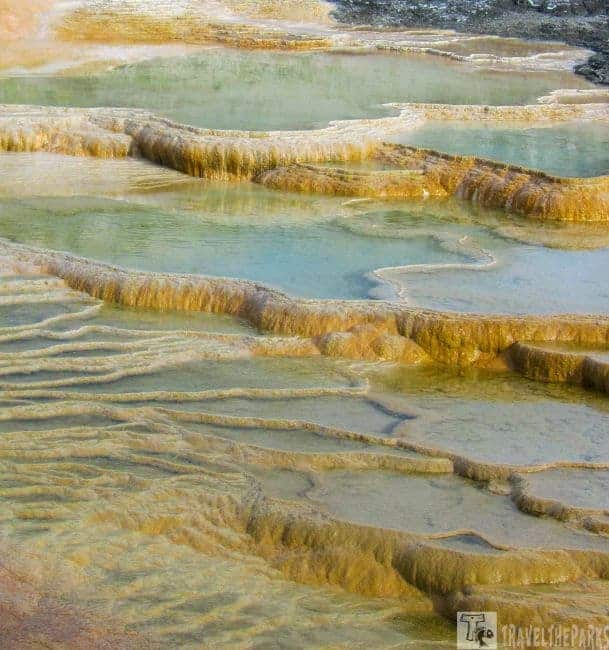
What I love most about this area is the abundant opportunities to sight wildlife, especially if you travel during the early morning hours. Today, we spot a single car pulled off the highway. Curious, we slow down, only to see a lone black bear ambling through the forest. The prospects of seeing animals like this happen quickly in Yellowstone, so always have your camera ready!!

Sheepeater Canyon Bridge-North Grand Loop Road
Just east of Mammoth Hot Springs, the North Grand Loop Road crosses the Gardiner River. We take a moment to stop at Sheepeater Canyon Bridge. It was breathtaking. You can hear the rushing waters of the Gardiner River as it makes its way to join the Yellowstone River.
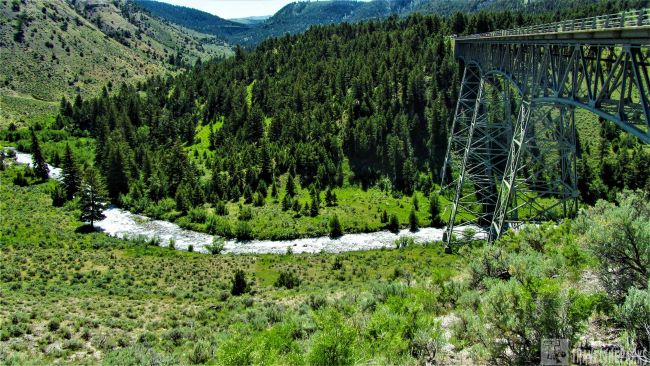
Constructed in 1915, the 925-foot-tall reinforced concrete arch spans Sheepeater Canyon. The Gardner River carved a small, deep valley that lay 70 feet below the surface. The Sheepeater Indians were a local Shoshone tribe band, and their name was given to the famous Warren Truss design bridge. It is listed on the National Register of Historic Places.
Note: a new bridge will be constructed beside this bridge. Automobile traffic will use the existing bridge while the new bridge is under construction. Not sure of the fate of the bridge once construction is complete.
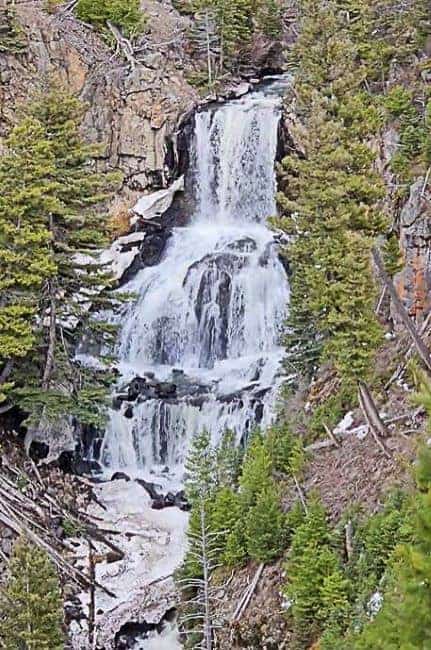
Spectacular Undine Falls on the North Grand Loop Road
The falls are located 4-miles outside Mammoth Hot Springs. There is a pullout off the north Grand Loop Road, where you can stop to view the falls. Lava Creek forms Undine Falls (pronounced UNdeen), which plunges over a 30-foot drop into a deep pool below after flowing down a succession of steep cascades.
Named Geologist-Arnold Hague, he thought the falls were mystical. The name “Undine” comes from German mythology and refers to a water spirit or nymph. The people thought the spirits lived around waterfalls and could gain souls by marrying mortal men. In June, because of snowmelt, the falls had a relatively high volume of water tumbling down the three rock tiers. We took some time to photograph these pretty waterfalls. Though it seems like humans, not the park service, constructed the unimproved trail that leads to the foot of the falls.
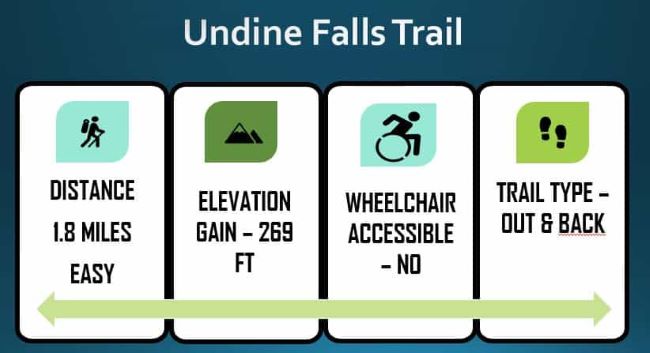
Lunch at Lava Creek Picnic Area on the North Grand Loop Road
It was a beautiful breezy day as we head down the Grand Loop Road, before stopping for lunch at the Lava Creek Picnic Area,. There are 5 picnic tables scattered along the edge of the Lava Creek. Lava Creek is known for its clear, cold waters. This is a marvelous spot to relax in the relative quiet, listening to the creek. We walked south along the creek for a little way, but did not see any animals. Lots of deadfalls across the trail.
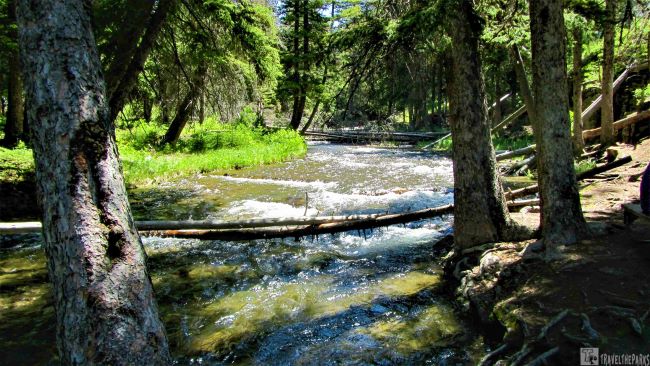
Lava Creek Canyon Trail-North Grand Loop Road
The trailhead is opposite the picnic area across the north Grand Loop road, on the northeast side of the bridge. Both people and wildlife use this heavily traveled trail. The trail is approximately 9.2 miles long and considered a moderate hike. This is best done as a one-way trail but requires two vehicles (return to Mammoth campground trailhead). The trail overall descends 1000 feet toward the Gardiner River. In the spring, the trail can be very muddy in spots. I would suggest sturdy walking or hiking shoes and quality trekking stick.
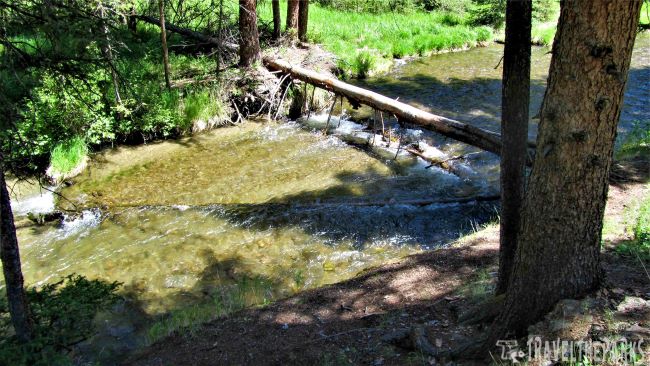
We did the trek to the falls and saw lots of amazing wildflowers. After a mile, we made it to the top of Undine Falls. We soaked our feet in the river before turning around for the uphill climb back to the picnic area. If you continue downhill through Lava Creek Canyon, the trail from here follows Lava Creek until it convergences with the Gardiner River. The trail along the river is through a sagebrush flat, reaching the bridge. You will need to cross the wobbly suspension bridge over Gardner River to complete the hike. NOTE: Currently, the bridge is down because of the flooding of 2022.
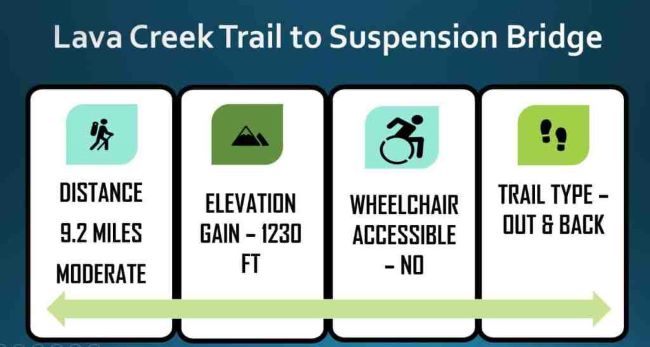
Three important facts come to mind if you plan to do this trial. First, make sure you are physically fit. Some parts of the trail near Undine Falls can be steep. Second, take a lot of water in a refillable water bottle and some snack food. You can refill water bottles at various water stations throughout the park. Third most important part to remember is that this is grizzly bear country, so bear spray is a must on the trail for your protection.
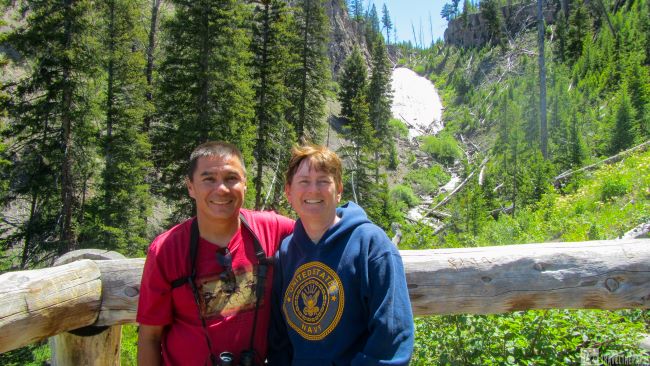
Hike Beautiful Wraith Falls along the North Grand Loop Road
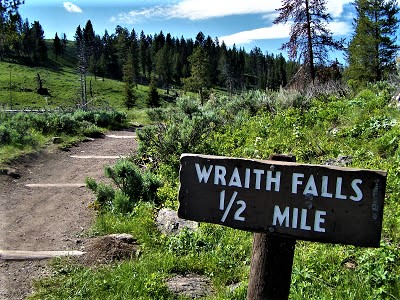
Wraith Falls is a 0.8-mile out and back trail. They rated it as an easy hike suitable for all skill levels. This 100 foot fall, cascade down a gentle slope as it empties into Lupine Creek. Heavily travelled, the trail is clearly marked and easy to follow. There is a raised overlook platform at the end that gives you outstanding views of the falls.
It is said that in 1885, a party from the U.S. Geological Survey, specifically Arnold Hague, thought they looked like an apparition or a ghost.
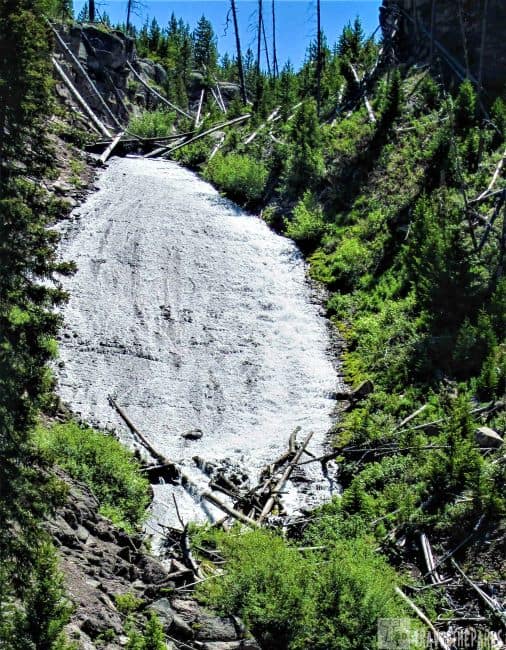
We found this to be an excellent hike for a stretch break. It’s a great option for those looking for a quick hike or for families with young children. This hike is easy level trail-moving through the meadow with lots of spring wildflowers and only has a moderate elevation gain near the falls. The trail provides an excellent opportunity for wildlife viewing, as the surrounding area is home to a variety of animals, including black bears, bison, and elk. On our trip, we saw a lone bison cruise through the meadow.
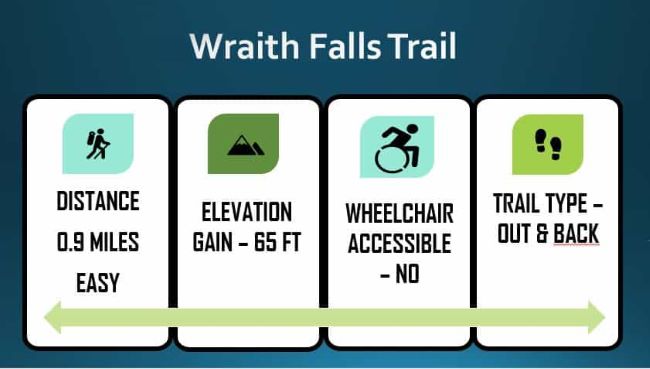
BlackTail Pond Hike
On the north side of the road, Blacktail pond is named after the black-tailed deer that can often be seen in the surrounding area. Blacktail Pond is a popular spot for fishing, as it is home to a variety of fish species, including cutthroat trout and brook trout. It is also a popular destination for wildlife viewing, with elk, bison, and other animals frequently seen in the area. In the early spring, look for trumpeter swans as they return here yearly.
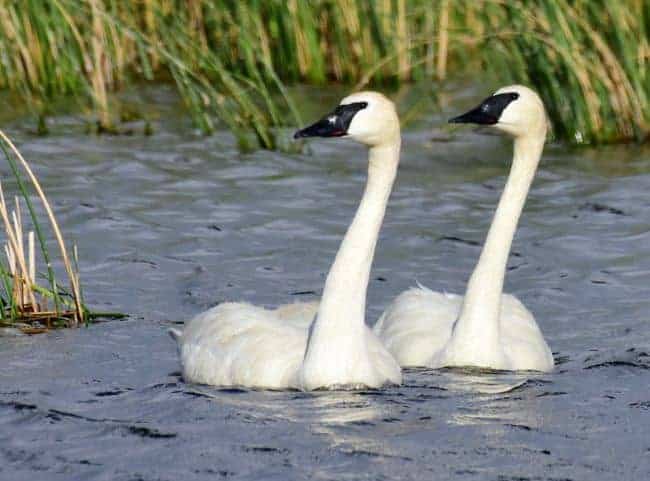
Detour taking Blacktail Plateau Drive
This one-way gravel road is 8-miles outside Mammoth Hot Springs. The 6-mile drive that takes about thirty minutes to drive. It will bring you back to the Grans Loop North roadway. However, if you have the time, it is a great way to get off the beaten path. At times, the road is rough and washboard in many places, but for us it was manageable. Just drive it slow. Throughout the drive, we watched carefully for bison, elk, deer, coyotes, and silently hoped possibly to see bears or wolves. Be sure to have binoculars and a camera with you, as they can enhance your wildlife viewing experience. There are several pullouts where you can stop and look for wildlife.
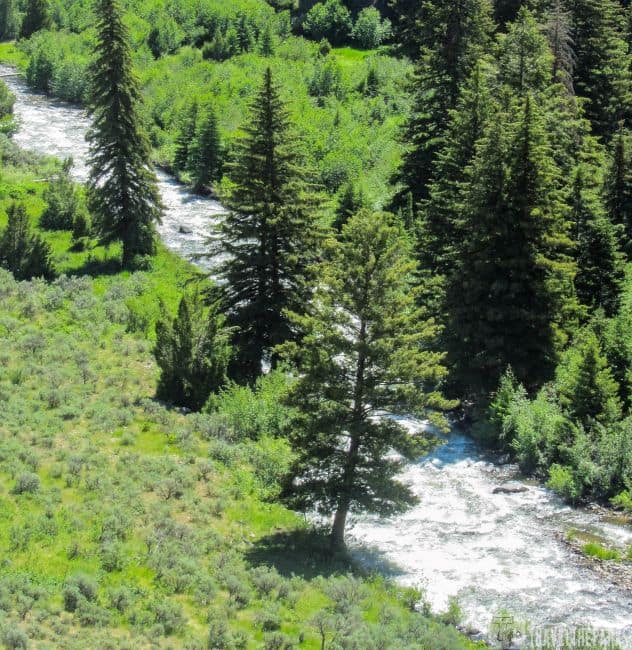
Blacktail Plateau Drive is typically open from late May or early June through October, weather permitting. During the winter months, the road is closed to vehicle traffic but can be used for cross-country skiing and snowshoeing.
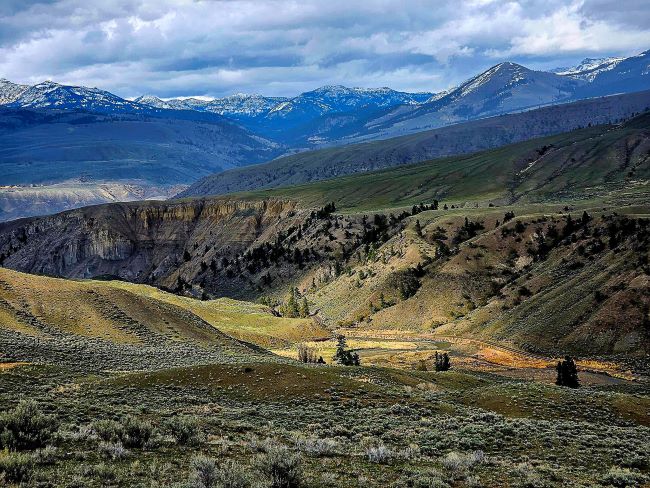
Floating Island Lake
This is another small kettle pond left behind by long-gone glaciers. It got its unusual name from what was thought to be a floating island of weeds that moved with the wind. The rolling hills here are a good place for spy pika. The shallow lake is an ideal place for birdwatching. Look for trumpeter swans, or sand-hill cranes. If you are really lucky, you may see a moose. Today we took the short trail down to see the Yellow-Headed Blackbirds nesting in the cattails that line the banks. However, a large herd of bison with calves was only a short distance away, and was moving in our direction, so we moved back towards the car.
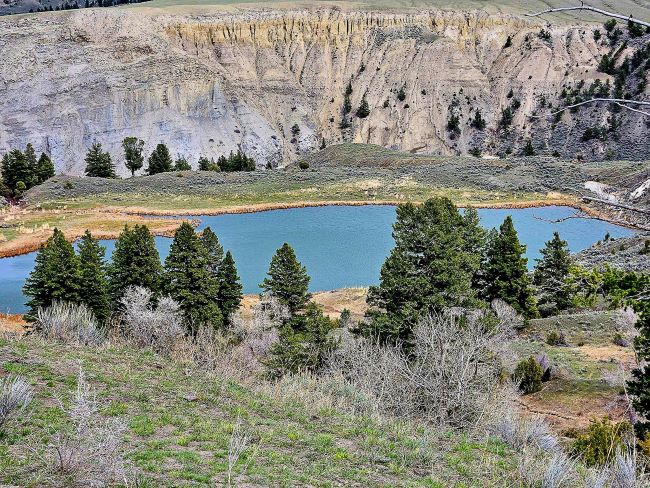
Hell Roaring Trail Overlook
From the overlook, visitors can see breathtaking views of the Hell Roaring Creek as it winds its way through the Lamar Valley. On a clear day, the Absaroka Mountains in the background are stunning. The overlook provided us with an excellent opportunity for wildlife viewing, as bison, elk, and other animals. The Hellroaring creek trail is 18.2-miles that can be strenuous. If you are up to the challenge, you will find it is a beautiful wilderness trail.

There is a small parking area at the overlook, as well as a short trail that leads to a higher vantage point for even more dramatic vistas. We found the trial is relatively easy and suitable for most skill levels. Because of my interest in geology, I noted that the canyon below was formed by the Hellroaring Creek, whose flow has shaped this terrain for millennia.

Stop at the Petrified Tree Along the North Grand Loop
The Petrified Tree in Yellowstone National Park is a unique and fascinating geological feature. The tree is one of the best preserved ancient redwoods in the world. Just before the intersection of the Tower-Roosevelt area, we drove the short dirt road to see the Petrified Tree. The parking lot was full, so we ended up parking on the side of the hill, then walking uphill to the overlook. Here we could view the Petrified Tree from a boardwalk that surrounds the base of the tree. Because of vandalism, they fenced around the tree. My hope is it will last 50 more years. It is impressive to look closely at the intricate details and patterns of the petrified wood.
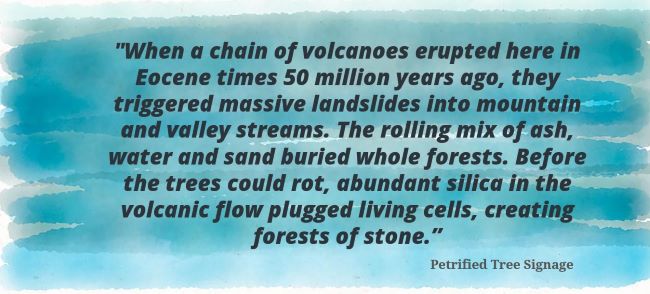
The Petrified Tree is a 50-foot-long fossilized tree trunk that dates back to the Eocene epoch, which was approximately 50 million years ago. Originally, the tree was a towering redwood that fell into a river. Where it became buried by sediment. Over time, minerals in the sediment replaced the tree’s organic material with stone, creating a petrified fossil.
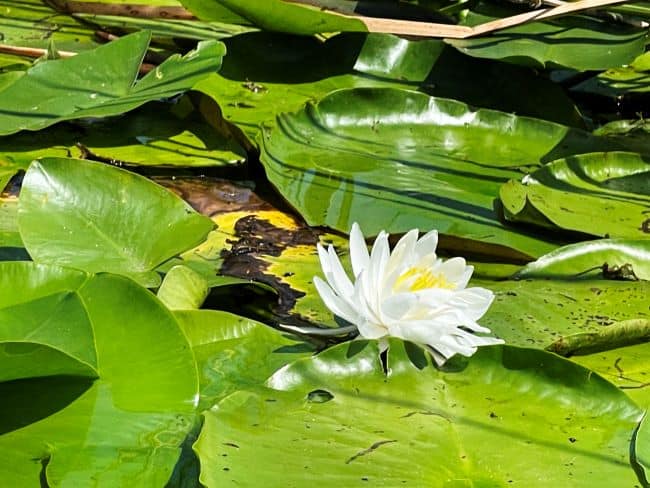
This area is a best in the early morning. Sometimes bear and moose frequent the lower meadows. The valley is lush and green with grasses that wildlife can browse on in the early spring.
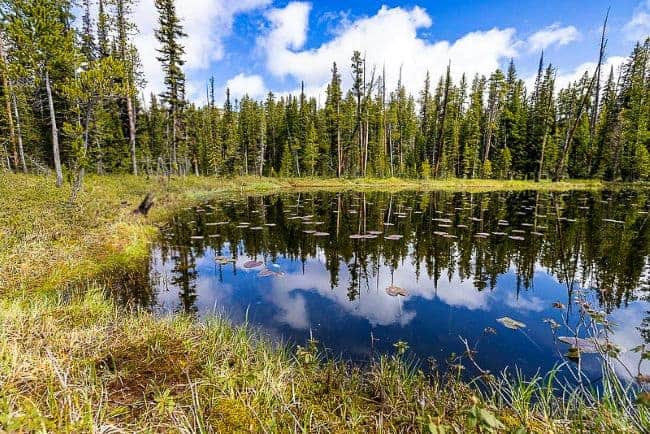
Hike to Lost Lake Trail Finding Solitude
Visitors can access the trail behind the Roosevelt Lodge and Cabins or from the Petrified Tree. If you begin at Roosevelt, the trail to Lost Lake is approximately 3.3 miles one way, with a total elevation gain of around 800 feet. If you start here, it will be a steep climb to the lake. However, the trail from the Petrified tree is 0.5 miles one way and is a relatively easy level trail. The highlight of the hike is Lost Lake, which is a spectacular alpine lake set in a high mountain valley. Towering peaks surrounded by dense forest ring this lake. For me, it provided a tranquil setting for a picnic lunch.
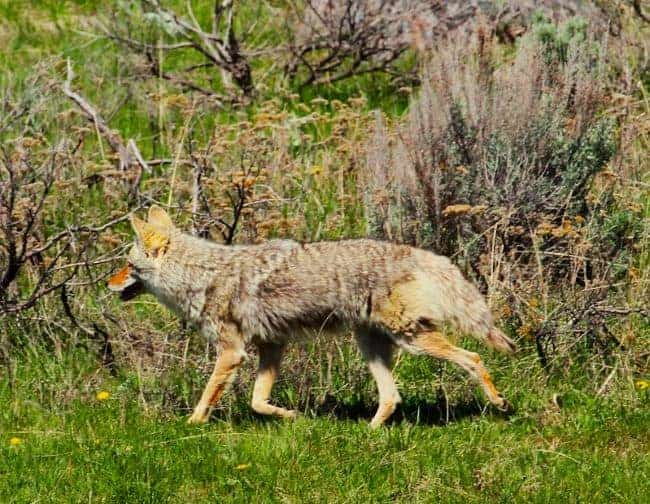
As with any hike in Yellowstone National Park, it’s important to come prepared with bear spray Other hikers mentioned, seeing a black bear on the trail earlier.
From Lost Lake, hikers can continue on to other nearby trails, including the Mount Norris Trail and the Cache Creek Trail. Both trails offer additional opportunities for exploration and adventure in this stunning wilderness.
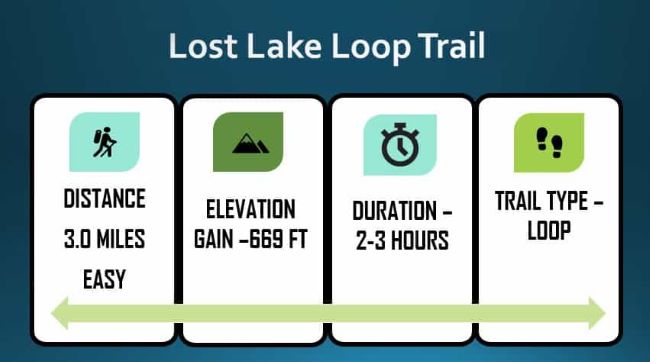
The Road to Tower Fall on Tower Creek
The Grand Loop Road turns south again after Tower Junction, heading toward Canyon Village. The next stop along the road is Tower Fall. This waterfall is on Tower Creek, a tributary of the Yellowstone River. Tower Creek originates from the Absaroka Mountains and flows through the northeast region of Yellowstone National Park.
Lower Falls drops 132 ft. down cascades down a series of rocky ledges into Tower Creek. This water travels only a short distance in the creek before converging with the Yellowstone River. The name “Tower” is derived from the nearby rock formations known as the Tower Junction. The Washburn expedition in 1870 named the creek for these towering volcanic spires that surround the falls.
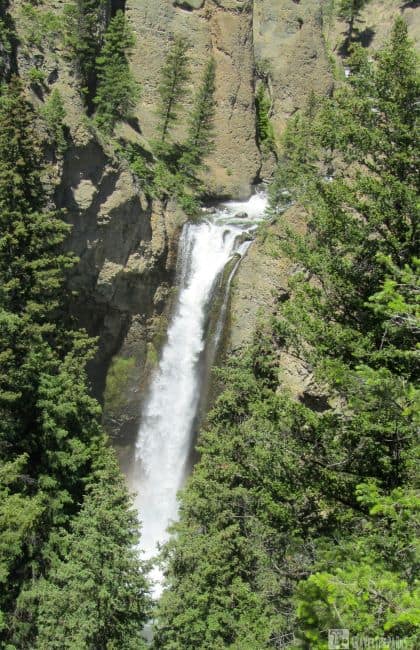
The waterfall is best viewed from a distance. Just off the Grand Loop road, parking is beside the Tower Fall General Store. From the overlook at the end of the parking area, we took in the scenic beauty. The area is a mix of forests, meadows, and rocky terrain.
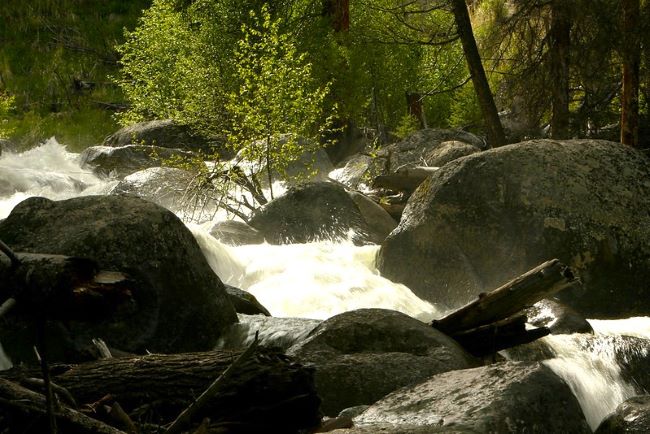
You can take a trail from the parking lot that goes down to the Yellowstone river below the falls. It is steep in a few places but will get you marvelous views of the river. Unfortunately, because of severe erosion, you can no longer take the trail to the base of the falls.
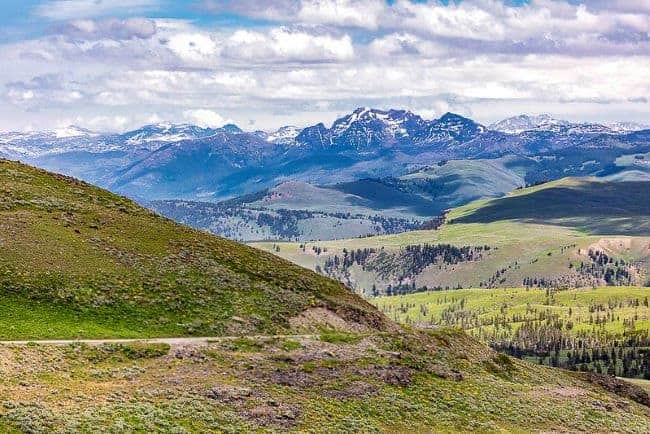
Dunraven Pass Highest Point on the Grand Loop Road
The pass is named after a former British politician, Edward William Dunraven, who visited the area in the late 19th century. Dunraven Pass is situated at an elevation of 8,859 feet (2,700 meters) above sea level and is the highest point on the park’s Grand Loop Road.
This section of winding drive is one of the most difficult in the park. Stopping at the top, we could see gorgeous views of the surrounding landscape, including the Absaroka Range to the east and the Gallatin Range to the northwest. We also noted the old burn scars and stunted trees from the 1988 fires. It gave us an eerie feeling. In some places, there was still snow at the top of the mountain. Taking advantage made snowballs and enjoyed a snowball fight. As the snow melts, we saw blooming valley flowers peaking through.
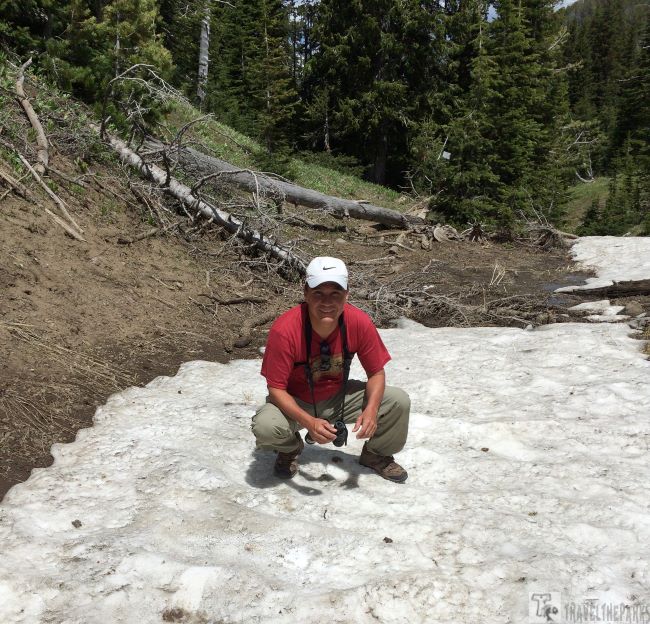
The area around the pass is home to a variety of hiking trails, including the Mount Washburn Trail, which offers panoramic views of the park from its summit. The park services notes that this pass is typically open from late May through October, depending on weather conditions.
Note: Check with the rangers before driving the pass is advisable since even summer snow can close the pass. Weather can change quickly in Yellowstone, so be sure to check the forecast before setting out on any hiking trails.
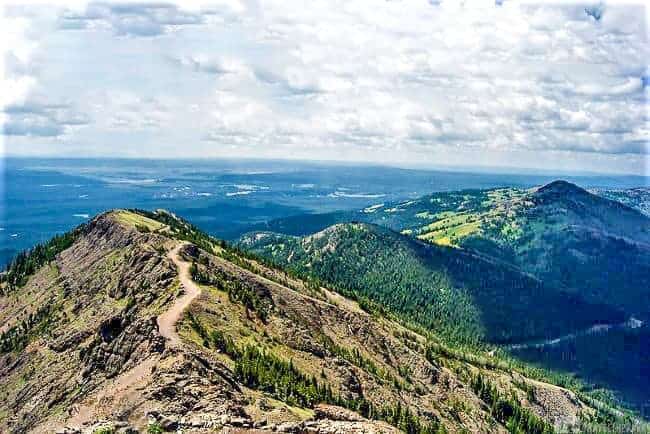
Hiking the Mount Washburn Trail
Mt. Washburn has to be the best view for the least amount of hiking in Yellowstone. From the Grand Loop Road., drive up Chittenden Rd. to the parking area, then hike an easy 2.5 miles on a gravel road (closed to autos) to the fire/observation station atop Mt. Washburn. Word of advice, be sure to wear comfortable walking shoes and bring a trekking stick suitable for hiking. Wear a jacket as it gets freezing as you climb higher in elevation to 3,000 feet. Once we reached the summit, it rewarded us with a panoramic 360-degree view of the park. The endless views include the Grand Canyon of Yellowstone, Hayden Valley, and the Absaroka Range. On a clear day, you may even see the Tetons in the distance. Today was a bit cloudy, so our views were a little obscured.
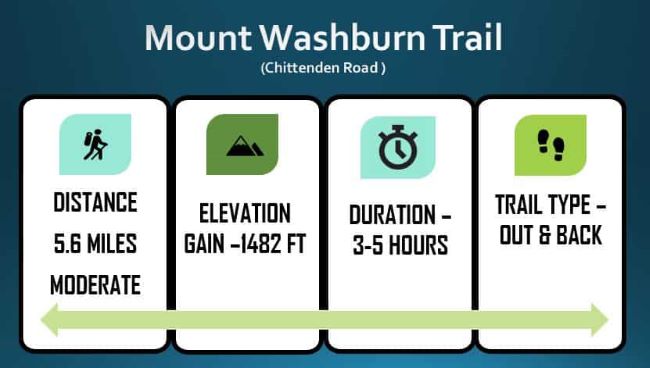
Alternatively, you can take the Mount Washburn Trail, which is approximately 6.2 miles round trip. It’s considered a moderate hike, with an elevation gain of about 1,400 feet. The trailhead is off Dunraven Pass between Tower Junction and Canyon Village. This trail starts in a dense forest and gradually ascends to the tree line. Along the way, hikers can enjoy views of wildflowers and wildlife, including bighorn sheep, marmots, and pika.
At the top, the views go on forever. You can see the entire park and the Tetons in the distance. There is a National Park Service Fire Lookout station at the Peak where you can take a breather before returning down the trail.
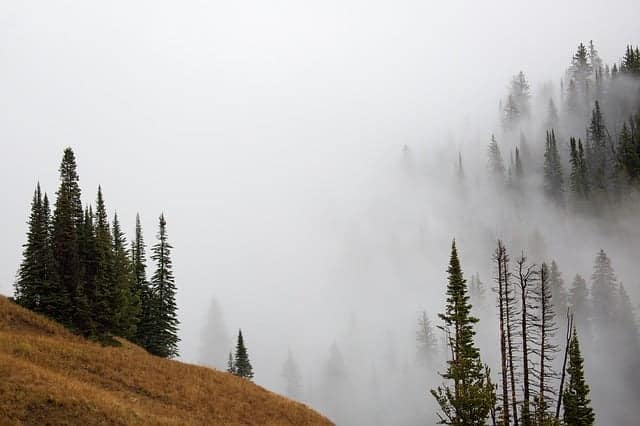
What to Know Trekking Along the North Grand Loop Road
Trekking along Yellowstone’s North Grand Loop Road offers some of the park’s most breathtaking scenery and wildlife viewing opportunities, but proper planning is key to making the most of your adventure. Here’s what you should know before you hit the road:
- Timing Is Everything: The North Grand Loop Road is busiest in mid-morning to mid-afternoon. For fewer crowds and better wildlife sightings, plan to start early in the morning or late in the afternoon. Seasonal closures can occur—typically from late fall through spring—so check current road conditions before you go.
- Wildlife Safety: The Lamar Valley portion of the loop is famous for its wildlife, including bison, elk, wolves, and bears. Keep a safe distance, use binoculars or a zoom lens, and never approach animals on foot or by vehicle. Always carry bear spray and know how to use it.
- Essential Gear: Dress in layers to adapt to changing temperatures and unpredictable weather. Bring water, snacks, a first-aid kit, and sturdy walking shoes if you plan to explore trails adjacent to the loop road. Don’t forget sun protection and insect repellent.
- Navigation and Maps: Cell service is limited in Yellowstone, so download offline maps or carry a printed map of the North Grand Loop Road. The official Yellowstone National Park website provides up-to-date road status and trail information.
- Facilities and Services: Along the North Grand Loop Road, you’ll find several visitor centers, restrooms, and lodges, such as Roosevelt Lodge. However, services may be limited, so stock up on essentials in nearby gateway towns before entering the park.
- Parking and Traffic: Popular stops like Tower Fall and Lamar Valley can get congested, especially during peak season. Patience is important—plan extra time for parking and always follow park regulations.
Planning Resources for the North Grand Loop Area
- Yellowstone National Park Official Website: Check for the latest updates on road conditions, closures, and visitor information.
- Yellowstone Road Status Updates: Essential for real-time info on which parts of the loop are open.
- Park Maps: Download or print detailed maps showing the North Grand Loop Road and trailheads.
- Wildlife Safety Guidelines: Available through the National Park Service website to prepare for encounters.
- Yellowstone Visitor Centers: Located near the loop, these offer maps, advice, and ranger-led programs.
- Local Lodging and Dining: Explore options in gateway towns like Cody, Gardiner, and Cooke City for accommodations and supplies.
- With thoughtful preparation, your trek along Yellowstone’s North Grand Loop Road will be a memorable journey filled with stunning landscapes and unforgettable wildlife encounters.
Final Thoughts on Traveling the Magnificent North Grand Loop Road
Note that although the Grand Loop Road may be congested sometimes (especially during peak season), the park’s vast size ensures you can always find solitude in the backcountry. Escaping the crowds in the park means you need to hike away from the road. Yellowstone does offer something for everyone.
For us, traveling on the picturesque Grand Loop Road in Yellowstone National Park was a wonderful experience. It had us appreciating the natural wonders of this incredible park. It was pure joy driving along the Grand Loop Road. We loved having the opportunity to explore these magical places firsthand. Whether you’re trekking to a waterfall or observing bison or other wildlife on the road, every moment in Yellowstone is unforgettable.
Have you traveled on the Grand Loop Road? Share with us your favorite spots and the trails you explored. We’d love to hear your experiences in the comments below!




